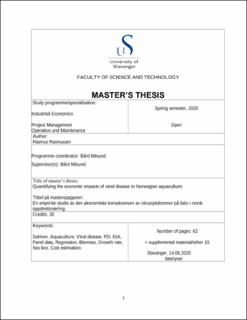| dc.contributor.author | Rasmussen, Rasmus | |
| dc.contributor.editor | Misund, Bård | |
| dc.coverage.spatial | Norway | en_US |
| dc.date.accessioned | 2020-10-19T07:37:26Z | |
| dc.date.available | 2020-10-19T07:37:26Z | |
| dc.date.issued | 2020-06-14 | |
| dc.identifier.uri | https://hdl.handle.net/11250/2683493 | |
| dc.description | Master's thesis in industrial economics | en_US |
| dc.description.abstract | Norway has since the advent of modern aquaculture been leading in the production of farmed Atlantic salmon. The industry has seen a rapid increase in production and combined with an overall increase in salmon price, the industry has been thriving in the second decade of the 2000s. With this rapid growth in mind, several biological challenges have emerged that are threatening the industry’s growth. As the sea pens have gotten larger and denser than ever, the consequences and prevalence of viral disease has increased. Pancreas disease is proven to decrease growth rates and increase production time. decreasing the farmers profit. This study tries to estimate these economic losses due to the reduction in growth rate cause by viral disease. The methodology has previously been used to successfully estimate the economic cost associated with sea lice and sea lice mitigation efforts like mechanical and bath treatments.
The change in biomass growth is estimated using dataset consisting of biophysical variables related to biomass, data on the prevalence and duration of viral diseases and some variables describing lice mitigation actions like mechanical treatments. The dataset consists of monthly data from 2012-2018, from 1041 fish farms stretching the entire length of Norway. Through a panel data estimator, the difference in biological growth rates where estimated and the cost of biomass loss due to viral disease could be computed.
As predicted the prevalence of PD reduced growth rates by a significant amount, an increase in sea water temperature and number of mechanical treatments had a negative impact on biomass growth in combination with PD. An increase in average fish weight reduces the losses associated with PD. An average PD infestation reduce the farmers profit by 15.16 MNOK, 15 % of total revenue lost. Averaging 7.15 NOK/kg of harvested fish. | en_US |
| dc.language.iso | eng | en_US |
| dc.publisher | University of Stavanger, Norway | en_US |
| dc.relation.ispartofseries | Masteroppgave/UIS-TN-ISØP/2020; | |
| dc.rights | Navngivelse 4.0 Internasjonal | * |
| dc.rights.uri | http://creativecommons.org/licenses/by/4.0/deed.no | * |
| dc.subject | industriell økonomi | en_US |
| dc.subject | fiskeoppdrett | en_US |
| dc.subject | lakseoppdrett | en_US |
| dc.title | Quantifying the economic impacts of viral disease in Norwegian aquaculture. | en_US |
| dc.type | Master thesis | en_US |
| dc.subject.nsi | VDP::Samfunnsvitenskap: 200::Økonomi: 210::Bedriftsøkonomi: 213 | en_US |
| dc.subject.nsi | VDP::Landbruks- og Fiskerifag: 900::Fiskerifag: 920::Akvakultur: 922 | en_US |

